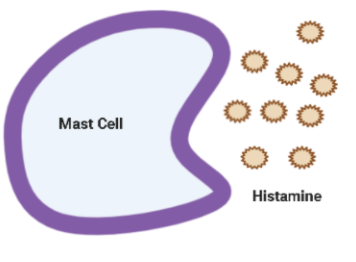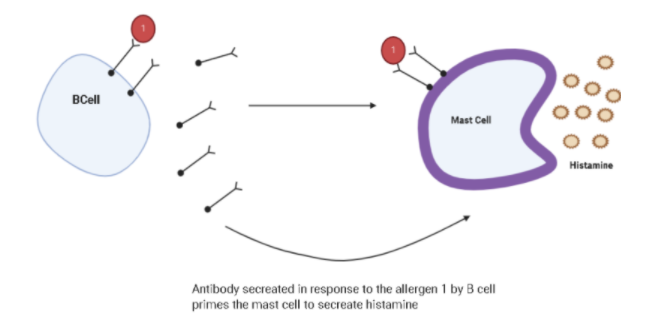Answer
414.6k+ views
Hint: Histamine is an organic nitrogenous compound that actively participates in inflammatory responses and is secreted by connective tissue.
Step by step answer:Histamine is a nitrogenous chemical compound actively involved in local allergic processes. It acts as a neurotransmitter in the central nervous system (CNS) and is the key mediator of itching. Histamine is involved in the contraction of smooth muscle tissues of the lungs, uterus, and stomach; the dilation of blood vessels, which increases permeability and lowers blood pressure.

-Fibroblasts are cells that synthesize the extracellular matrix and are involved in providing a framework to the body.
-Histiocytes are a type of WBC produced by the bone marrow. They are normally called macrophages. These are involved in phagocytosis and the clearing of the pathogens.
-Lymphocytes are a type of WBC which forms the major adaptive immunity response. They are further divided into B and T cells depending on their site of maturation i.e. bone marrow and thymus respectively. The B cell is antibody-secreting cells and produces antibodies rapidly against a pathogen when encountered.
-Mast cells are a migrant cell of the connective tissue that is rich in histamine and heparin granules. These are a type of granulocytes made up of the myeloid lineage of the bone marrow. They play an important role in type 1 IgE mediated allergic responses and anaphylaxis.

So, the correct option is option D.
Note: B cells secrete antibodies that trigger the mast cell to release histamine. But directly mast cells are only involved in the histamine secretion. Also, mast cells release histamine in response to an allergen triggering it. The histamine released will trigger vasodilation, and contraction of smooth muscles.
Step by step answer:Histamine is a nitrogenous chemical compound actively involved in local allergic processes. It acts as a neurotransmitter in the central nervous system (CNS) and is the key mediator of itching. Histamine is involved in the contraction of smooth muscle tissues of the lungs, uterus, and stomach; the dilation of blood vessels, which increases permeability and lowers blood pressure.

-Fibroblasts are cells that synthesize the extracellular matrix and are involved in providing a framework to the body.
-Histiocytes are a type of WBC produced by the bone marrow. They are normally called macrophages. These are involved in phagocytosis and the clearing of the pathogens.
-Lymphocytes are a type of WBC which forms the major adaptive immunity response. They are further divided into B and T cells depending on their site of maturation i.e. bone marrow and thymus respectively. The B cell is antibody-secreting cells and produces antibodies rapidly against a pathogen when encountered.
-Mast cells are a migrant cell of the connective tissue that is rich in histamine and heparin granules. These are a type of granulocytes made up of the myeloid lineage of the bone marrow. They play an important role in type 1 IgE mediated allergic responses and anaphylaxis.

So, the correct option is option D.
Note: B cells secrete antibodies that trigger the mast cell to release histamine. But directly mast cells are only involved in the histamine secretion. Also, mast cells release histamine in response to an allergen triggering it. The histamine released will trigger vasodilation, and contraction of smooth muscles.
Recently Updated Pages
How many sigma and pi bonds are present in HCequiv class 11 chemistry CBSE

Why Are Noble Gases NonReactive class 11 chemistry CBSE

Let X and Y be the sets of all positive divisors of class 11 maths CBSE

Let x and y be 2 real numbers which satisfy the equations class 11 maths CBSE

Let x 4log 2sqrt 9k 1 + 7 and y dfrac132log 2sqrt5 class 11 maths CBSE

Let x22ax+b20 and x22bx+a20 be two equations Then the class 11 maths CBSE

Trending doubts
Fill the blanks with the suitable prepositions 1 The class 9 english CBSE

At which age domestication of animals started A Neolithic class 11 social science CBSE

Which are the Top 10 Largest Countries of the World?

Give 10 examples for herbs , shrubs , climbers , creepers

Difference between Prokaryotic cell and Eukaryotic class 11 biology CBSE

Difference Between Plant Cell and Animal Cell

Write a letter to the principal requesting him to grant class 10 english CBSE

Change the following sentences into negative and interrogative class 10 english CBSE

Fill in the blanks A 1 lakh ten thousand B 1 million class 9 maths CBSE



